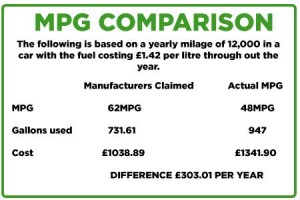So no matter what vehicle make or model you buy, or if its petrol or diesel, you will no doubt know that it is nearly impossible to reach the figures quoted by the manufacturer for its Miles Per Gallon (MPG). So how do manufacturers come to their figures and why are they allowed to advertise this, when in the real World you’re never going to actually see those figures claimed.
Fuel economy is a high deciding factor when choosing your next vehicle, this can have a major impact on your yearly motoring costs. The average motorist is reported to do an average of 12,000 miles per year in their vehicle, if this is a diesel car with an average price at the pump of £1.42 per litre and a claimed MPG from the manufacturer of 62mpg, it would cost you £1038.89 in diesel. If you saw an average of 48mpg for your vehicle it would then cost you £1341.90 for the year, that’s an increase in the cost of £303.01 (that is assuming the price remains the same throughout the year for the diesel). This is a considerable difference over a typicals years motoring.
So how does the manufacturer get away with quoting these seemingly inflated MPG figures? All vehicle MPG figures are governed by the New European Driving Cycle (NEDC), these official figures are obtained by strict test guidelines and these are the only figures that the manufacturers are allowed to quote.
The problem with these tests is that they are carried out in exact ‘laboratory’ conditions. The vehicle is subject to tests with all the usual electrical equipment turned off (lights, radio, air conditioning), on a flat rolling road and at a controlled ambient temperature.
The extra-urban results for example, though these results are obtained with the vehicle accelerating and decelerating, this is done at a very slow rate, a lot slower than normal and over a very short distance (accelerating to 9mph in 4 seconds and over only 4.3miles). If you don’t think there’s anything wrong with that, you try doing that on the road and you’ll see just how slow that actually is.
The Urban figures are obtained over an even shorter distance of just 2.5miles. So baring all these factors in mind, you can see why it’s near on impossible to get the manufacturers claimed MPG.
When buying a brand new vehicle you may even see an even lower MPG until after the initial 12,000 miles, as the engine will ‘loosen up’ and then could start giving you a higher MPG. If your vehicle has already ‘loosened up’, a fair bet would be to reduce any claimed MPG by the manufacturer by 10% to get nearer the actual MPG under normal driving conditions.
So until the rules are changed and the manufacturers start publishing real life MPG figures based on driving the vehicle in the real World in real conditions, we will always see what seem like inflated MPG claims. Let’s hope the changes are made sooner rather than later and we can truly budget for the true MPG when buying a new car.